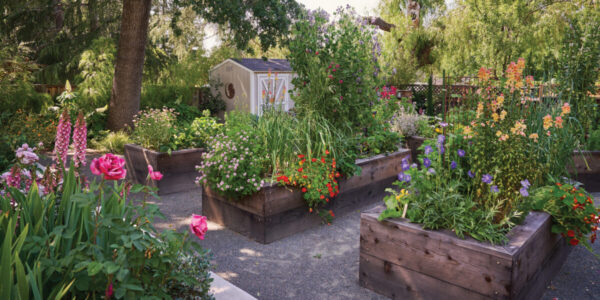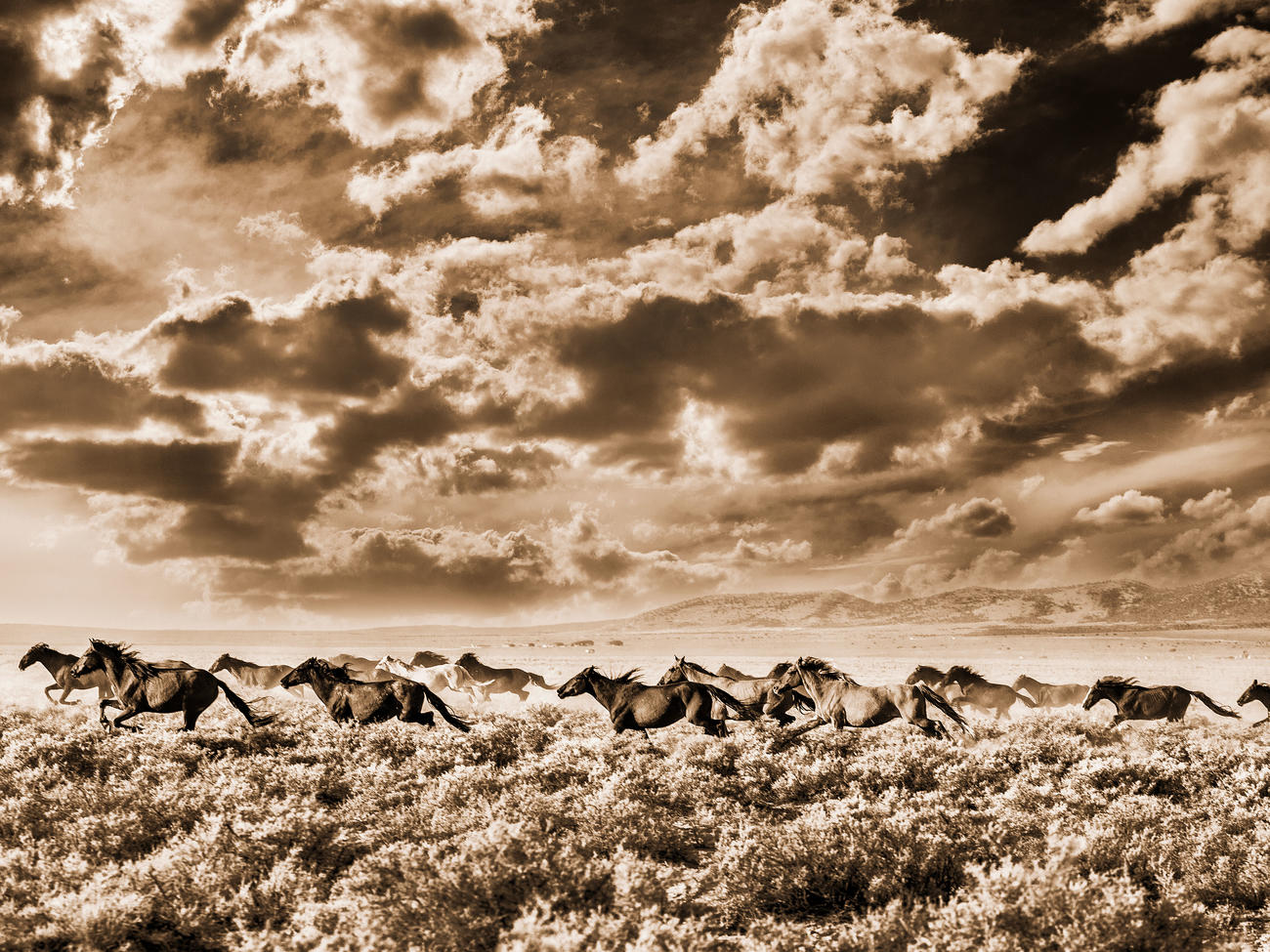
The Fight over America’s Wild Horses

“Horse people,” a guy named Monty in a cowboy hat tells me, “always cry when they leave here.” We are at Mustang Monument, a 900-square-mile luxury eco resort and wild-horse reserve in the middle of the Nevada high country. I was invited by owner and Saving America’s Mustangs founder Madeleine Pickens, former wife of billionaire T. Boone, to spend a weekend with the 600 horses that have lived here since she rescued them. Elements of the trip I had anticipated included horseback riding, mountain scenery, and large-animal majesty. Inspiration, probably. Dazzled gasping, maybe. But crying?
“Really?” I ask.
“Oh, yeah,” Monty says.
Full disclosure: I’m not what you’d call a “horse person.” I do not, like the two Brits also here, have riding boots, helmets, leather half-chaps, and dressage expertise. But I do possess a ribbon for first place in a cantering contest I participated in as a 12-year-old and also wave at horses on roadside farms whenever I pass them in my car.
By this third day at the resort, though, I’m surprisingly underwhelmed by the wildlife. Each evening, we gather in the bar, a stand-alone wooden structure on the property with Old-West-as-interpreted-by-Pottery-Barn decor, order cocktails, and retire to the porch outside. There, sitting on stools topped with riding saddles, we can observe Pickens’s herd in the distance, kicking up clouds of dust on the horizon as they race across the mountainous acreage. This is the iconic image: the running, the mane flying, the rampant, muscular freedom of it all! But by now I knew that up close, America’s wild horses look like regular horses—only punier.
“They are a part of our history,” Pickens said when she joined us on the porch back on the first night in a crisp white shirt, jeans, and huge turquoise-studded belt. For years, she had owned and raced thoroughbreds before adopting the mustangs in 2008. She opened this resort to provide a home for wild horses as well as a safari experience to those who want to get close to them and who will, she hopes, join the crusade to save them. Because while on this side of Mustang Monument’s gates there are $1,200-a-night designer tipis, deep, immaculate bathtubs, and weepy horse lovers, on the other side there are some who think that mustangs should be slaughtered.
The fight about wild horses is certainly part of American history. In 1971, President Richard Nixon signed the Wild and Free-Roaming Horses and Burros Act into law. For decades prior, activists campaigned to get the animals, whose numbers were dwindling, protected; the act forbade killing them and charged the Bureau of Land Management with their supervision. Even though mustangs are not native but rather the offspring of horses brought to America by European settlers, Public Law 92-195 declared the animals “living symbols of the historic and pioneer spirit of the West.”
Today, 72 percent of Americans support their protection. Seventy-two percent of Americans also do not live anywhere near wild—or, more properly, feral—horses, which are descended from a once-domesticated species. Here in Nevada, where the majority of the horses live, they are the subject of screaming matches at town meetings, multisided lawsuits, and family rifts. At issue, essentially, is grass: Ranchers lease public land to graze their cattle. Mustangs, which reproduce quickly—there are currently an estimated 50,000 roaming in the United States, but the population could reach 100,000 in five years—overpopulate their federally granted range, leading them to wander onto ranchers’ land. There’s simply not enough grass to feed cattle and horses.
So the BLM rounds up some of the horses and places them in adoption facilities. At least, it used to. BLM budget cuts have left money for infrequent gathers, and adoption facilities are full, with some 48,000 horses and burros already in holding. Additional mustangs are in the care of contractors the government pays—which alone costs taxpayers $43.2 million a year. No matter how you look at it, America has a wild-horse problem.
Before I arrived at Mustang Monument, I’d expected to come away from the experience 100 percent on Team Horse. I’d been excited about the prospect of our first day’s activity, a long horseback ride up Spruce Mountain. That morning at breakfast in the dining room, the British gals decked out in their riding boots and pants, we met Clay, our cowboy leader, and part of the two-man team that Pickens affectionately refers to as her “Marlboro men.” Clay’s a tall, sturdy, be-Stetsoned local whose college education was facilitated by a rodeo scholarship and who bears a passing resemblance to actor John Corbett. With him is the aforementioned Monty, a hunky, tobacco-chewing former Navy SEAL with a jawline so sharp, you could use it to solve geometry equations. We followed Clay and his trailer full of horses out to the base of the mountain trail.
My horse for the day was a real-live wild mustang that had been gathered by the BLM and domesticated. He was black and tall for a wilding. He was also, from the second he was unloaded, and only more so after I mounted him, not happy.
We wound our way up through desert plants that cracked as we trampled them, my horse skittish and ornery, difficult to control. When I wasn’t overwhelmed with trying to keep him in line, I looked around and breathed the expansive wilderness in deep. We passed a tiny abandoned mining settlement that looked like a Hollywood set, a few dilapidated wooden buildings among the brush. At the top, we dismounted and stood in the crisp wind, looking out onto endless stretches of valleys between mountains that undulated farther than we could see, not a speck of cultivation or civilization on them. The Brits gaped as if at a wonder of the world. “There’s so much land,” they said.
After a picnic lunch, I remounted my uncooperative steed. He refused to stay with the other riders, took off galloping, and nearly tossed me. I recognized that some of it was surely my fault as a nonhorse person. (“It’s not your fault!” the Brits, in their horse-people outfits, called out to me periodically and with pity.) But by the end of the five-hour mountain trail, I confess that I was less inclined to cry over mustangs than to punch my particular one in the face.
“It’s not cool to stand up for wild horses around here,” Clay told me my last morning at the resort. We were sitting on a sunny deck off the main dining room finishing our breakfast. When he came to work for Pickens three years ago, some members of his family stopped speaking to him. Not that he even was standing up for wild horses; he just doesn’t think “you should shit-can a whole species because it’s inconvenient.” But in Nevada, there is no room for moderate feelings. “This is about ranchers versus liberal hippies who don’t know better” is the mind-set.
Take rancher Jim Boyer, a managing partner of the Pequop Nature Conservancy, whose property borders Mustang Monument. In 2008, 14 wild horses wandered onto that land. Today, there are more than 200 mustangs squatting there. “The only solution,” he said when I reached him by phone, “is to slaughter and eat them.” He repeated this three times during our conversation and described the position as “middle of the road.”
In the spring of 2014, a group of ranchers in Utah hit the BLM with a lawsuit demanding it remove the number of horses above the sustainable population number. Around the same time, another group of ranchers settled a similar lawsuit against the BLM in Wyoming. Simultaneously, that Wyoming BLM was being sued by mustang advocates, who demanded that it not remove horses.
“I want you to think of it as terrorism,” Pickens said of the BLM’s management. According to Pickens and other horse advocates, most problems related to mustangs are caused by the BLM, which exaggerates their overpopulation problem and fails to give them enough good or dedicated rangeland. The fight has turned ugly. People—nobody knows who, exactly—have broken fences meant to contain horses, including fences in Lyon County, Nevada, where mustangs subsequently entered city parks, pooped all over, and tore up the turf. The week before I visited Mustang Monument, a Reno Gazette-Journal story showed wild horses standing around the parking lot of an ugly commercial building.
The day after I leave Mustang Monument, I meet Lesli Ellis-Wouters, a public affairs specialist at the BLM. “We’re not always right,” she concedes. “But,” she says, sounding frustrated and throwing her hands up, “we try.” She is with Bruce Thompson, the BLM’s wild-horse specialist for Elko District, which covers 7 million acres.
We drive for a long time through a dry, scrubby landscape of nothing, intermittent cattle fences, then more nothing. “People always say there’s so much land,” says Ellis-Wouters. “They say, look at all the forage.” But. She and Thompson point out the individual plants in an impromptu botany lesson. This plant here is poisonous. This one that you see everywhere has zero nutritional value. This one is great, but it can’t tolerate summer grazing—you have to be careful how far down you graze it or it dies forever. And free-roaming horses are anything but careful. They accidentally kill forage, and once forage is truly dead, you can attempt to replant it, which requires a good deal of money and maintenance but often doesn’t take. “You’ve got better odds of winning in Vegas,” Thompson says.
So in this wide-open vastness in which we’re standing, there are one or two good plants for eating, and one of them is temperamental. Horses have to eat 15 to 20 pounds of forage a day, each. They also have to drink 12 to 15 gallons of water daily. We take another long drive to a natural spring on land designated for wild horses. It’s hardly necessary to get out of the car to see that the spring is no longer: The drought has turned it to a puddle of mud. Horses looking for a drink recently ended up buried in the mud up to their withers. We drive to another spring, where the BLM has built a trough. When Thompson checks the pipe that feeds it, drops of water are falling out slowly, despite a recent rain. This water flow, he says, is “too weak to measure.” In 2013, the district spent $50,000 hauling water to the horses. Another nearby district had spent $130,000, before the season was even over.
“When you see these horses that can’t get water, it’s awful,” Jolene Supp, the city manager of nearby Wells, Nevada, tells me. You don’t have to be an expert to recognize a starving horse, she says, and with the amount of sustenance available and the number of horses, she’s seen plenty.
There is of course no such problem at Mustang Monument. One popular resort activity is accompanying Clay to feed the herd with a big wagon full of hay. We’d watch him harness up the two draft horses that draw it, a pair of enormous, magnificent steeds standing improbably tall and impressive in their black-and-white coats. We hopped on the back of the cart with the mountain of hay as Clay steered us out into the herd, more than a hundred of them heading slowly, cautiously in our direction, until they were right on top of us. They ate quietly under the clear blue sky, their occasional snorts filling the silence of a field full of wild, satiated beasts, calm but with their glassy eyes still on us.
I drive five hours southeast to Delta, Utah, home to the Delta Wild Horse and Burro Facility, one of the BLM’s 16 permanent adoption facilities nationwide. It’s a big lot at the edge of a residential neighborhood, and I am the only visitor there.
Lisa Reid, a BLM public affairs specialist for the local wild-horse program, tells me that only 30 to 50 mustangs get adopted each year here, usually in spring. Like the rest of the BLM’s adoption centers, this one is full. When I bring up a recent lawsuit that would prevent the BLM from gathering any more horses in Wyoming, Reid shrugs. “They’ve got no place to put them,” she says.
We walk back to where the horses (and some burros) are held, a series of a dozen or so pens arranged in long rows with dirt walkways between them. Most of the pens are full. In one is a group of mustangs that was gathered three months ago. In another stands a group gathered just one month ago.
These most recently gathered horses are a rough, sad bunch, the kind of horses you definitely want to cry over. They’re starving, every rib visible through their dull, matted coats. This is the shape, Reid says, that population pressure and drought leaves them in. The horses that have been fed by BLM for three months could be the dramatic “after” picture in a brochure. No visible ribs. Shiny coats. The rest of the horses here, which have been in longer, a year or more, are even beefier and shinier. This facility is like a living, three-dimensional advertisement of the need for better solutions.
Some experts have recommended putting horses down. Others suggest more aggressive adoption programs. Or developing longerlasting birth control than the two-year shots the BLM occasionally darts mustangs with. (Some advocates support that concept; others oppose it as unnatural.) Still others endorse the idea of sending America’s ranchers packing or downsizing their cattle herds to make way for more horses to roam and forage—at least until the land can no longer sustain them or other solutions emerge. In the meantime, animals suffer. People do too.
I think back to Clay and the relatives who shunned him for working with Pickens. “We’re good now,” he assured me. He’d made them see the nonsense of breaking up a family over a job, over a horse, although he seemed disappointed that they’d taken it so far. “We’re good now,” he repeated, “but there’s still a void there.”
There also remains a void in public awareness of how complex the wild-horse issues are. At Mustang Monument, we didn’t get a particularly nuanced education in them—but we did get closer to America’s free-roaming horses than is possible anywhere else.
I didn’t see if the British horse people cried when they left the ranch. But on their last two days, I did notice them checking their phones for news about a volcano in Iceland that had been rumbling, worrying that it would erupt as disastrously as the one in 2010. The Brits prayed audibly that it would, spewing out millions of cubic meters of ash, disrupting flights for millions of travelers—and keeping them here, with the horses, a little longer.
WHERE THE WILD HORSES ARE
There are more than a few ways to view mustangs in the West, from trail rides to safari adventures. Here are our top spots.
Mustang Monument, Wells, NV. This resort comes with luxury tipis and enough activities to make your equine-loving head spin, including rides through the gorgeous Goshute Valley. One lodging option is to sleep in one-bedroom converted wagons. From $1,200/night/2 guests, including meals, drinks, and activities; end of May–Sep; mustangmonument.com.
Spotted Fever Ranch, San Acacio, CO. Surrounded by 360° views of Colorado’s snowcapped mountains, Rick and Pat Binger’s ranch hosts guests all year long. For prime mustang viewing, groups of six ride out across the Rio Grande. Stay a couple of days and you can take part in a cattle drive, brand longhorns, and play with foals. From $225; spottedfeverranch.com.
Wild Horse Sanctuary, Shingletown, CA. Saddle horses will take you on a ride through the foothills outside of California’s Lassen National Forest, where you’ll spot herds of their wild cousins. In a frontier-style camp, dine on barbecue tri-tip over the fire, beans, and corn on the cob. From $475/2-day trail ride; May–Oct; wildhorsesanctuary.org.
Deerwood Ranch Wild Horse Eco-Sanctuary, 30 miles west of Laramie, WY. Wyoming’s Snowy Range Mountains are home to elk, antelope, deer, and plenty of mustangs, the most curious of which will get close enough so you can touch their noses. Take it all in on an ATV ($40/2 hours); at night, retire to a 2-bedroom cabin, furnished with handmade pieces crafted from wood salvaged on the ranch. From $200; deerwoodstation.net.
Mac McClelland’s latest book is Irritable Hearts: A PTSD Love Story. Her work appears in The New York Times Magazine and Rolling Stone. Photographer Brown Cannon III has shot for Audubon, Outside, and Travel + Leisure.
